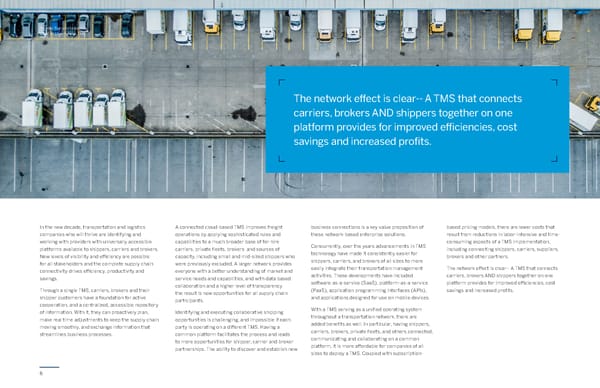6 Trimble Transportation What to Look for in a TMS In the new decade, transportation and logistics companies who will thrive are identifying and working with providers with universally accessible platforms available to shippers, carriers and brokers. New levels of visibility and efficiency are possible for all stakeholders and the complete supply chain connectivity drives efficiency, productivity and savings. Through a single TMS, carriers, brokers and their shipper customers have a foundation for active cooperation, and a centralized, accessible repository of information. With it, they can proactively plan, make real time adjustments to keep the supply chain moving smoothly, and exchange information that streamlines business processes. The network effect is clear-- A TMS that connects carriers, brokers AND shippers together on one platform provides for improved efficiencies, cost savings and increased profits. Trimble Transportation What to Look for in a TMS business connections is a key value proposition of these network-based enterprise solutions. Concurrently, over the years advancements in TMS technology have made it consistently easier for shippers, carriers, and brokers of all sizes to more easily integrate their transportation management activities. Those developments have included software-as-a-service (SaaS), platform-as-a-service (PaaS), application programming interfaces (APIs), and applications designed for use on mobile devices. With a TMS serving as a unified operating system throughout a transportation network, there are added benefits as well. In particular, having shippers, carriers, brokers, private fleets, and others connected, communicating and collaborating on a common platform, it is more affordable for companies of all sizes to deploy a TMS. Coupled with subscription- based pricing models, there are lower costs that result from reductions in labor-intensive and time- consuming aspects of a TMS implementation, including connecting shippers, carriers, suppliers, brokers and other partners. The network effect is clear-- A TMS that connects carriers, brokers AND shippers together on one platform provides for improved efficiencies, cost savings and increased profits. A connected cloud-based TMS improves freight operations by applying sophisticated rules and capabilities to a much broader base of for-hire carriers, private fleets, brokers and sources of capacity, including small and mid-sized shippers who were previously excluded. A larger network provides everyone with a better understanding of market and service needs and capabilities, and with data based collaboration and a higher level of transparency the result is new opportunities for all supply chain participants. Identifying and executing collaborative shipping opportunities is challenging, and impossible if each party is operating on a different TMS. Having a common platform facilitates the process and leads to more opportunities for shipper, carrier and broker partnerships. The ability to discover and establish new
 What to Look for in a TMS Page 5 Page 7
What to Look for in a TMS Page 5 Page 7